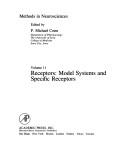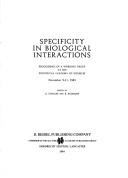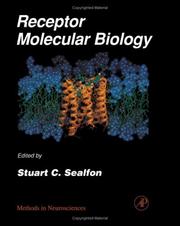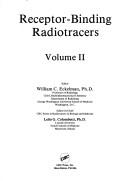| Listing 1 - 10 of 139 | << page >> |
Sort by
|
Book
ISBN: 1349059293 Year: 1981 Publisher: London : Macmillan Press Ltd.,
Abstract | Keywords | Export | Availability | Bookmark
 Loading...
Loading...Choose an application
- Reference Manager
- EndNote
- RefWorks (Direct export to RefWorks)
Book
Year: 1984 Publisher: Città del Vaticano : Pontificia academia scientiarum,
Abstract | Keywords | Export | Availability | Bookmark
 Loading...
Loading...Choose an application
- Reference Manager
- EndNote
- RefWorks (Direct export to RefWorks)
BIOCHEMISTRY --- BINDING SITES (BIOCHEMISTRY) --- CHEMICAL AFFINITY --- CHEMICAL REACTIONS --- MOLECULAR ASSOCIATION
Book
ISBN: 0387102051 3540102051 3642815057 3642815030 Year: 1980 Publisher: Berlin : Springer,
Abstract | Keywords | Export | Availability | Bookmark
 Loading...
Loading...Choose an application
- Reference Manager
- EndNote
- RefWorks (Direct export to RefWorks)
Enzymes --- Molecular association --- Binding sites (Biochemistry) --- Chemical affinity --- Congresses. --- Enzymology --- Molecular biology

ISBN: 1483259706 0121852717 1322054614 9780121852719 0121852725 9780121852726 Year: 1993 Publisher: San Diego, California : Academic Press, Inc.,
Abstract | Keywords | Export | Availability | Bookmark
 Loading...
Loading...Choose an application
- Reference Manager
- EndNote
- RefWorks (Direct export to RefWorks)
Receptors
Cell receptors. --- Cell membrane receptors --- Cell surface receptors --- Receptors, Cell --- Binding sites (Biochemistry) --- Cell membranes --- Proteins

ISBN: 902771813X Year: 1984 Publisher: Dordrecht, Holland ; Boston : Hingham, MA, U.S.A : D. Reidel Pub. Co. ; Sold and distributed in the U.S.A. and Canada by Kluwer Academic Publishers,
Abstract | Keywords | Export | Availability | Bookmark
 Loading...
Loading...Choose an application
- Reference Manager
- EndNote
- RefWorks (Direct export to RefWorks)
Biochemistry --- Chemical reactions --- Binding sites (Biochemistry) --- Molecular association --- Chemical affinity --- Congresses.

Abstract | Keywords | Export | Availability | Bookmark
 Loading...
Loading...Choose an application
- Reference Manager
- EndNote
- RefWorks (Direct export to RefWorks)
Binding sites (Biochemistry) --- Biological transport, Active --- Biopolymers --- Cell receptors --- Cytochemistry --- Congresses

ISBN: 9781420052985 1420052985 Year: 2008 Publisher: Boca Raton CRC Press
Abstract | Keywords | Export | Availability | Bookmark
 Loading...
Loading...Choose an application
- Reference Manager
- EndNote
- RefWorks (Direct export to RefWorks)
"Introduction to Macromolecular Binding Equilibria gives students in medicinal chemistry, pharmaceuticals, and bioengineering the necessary background in biophysical chemistry for research applications in drug discovery and development. Building upon a fundamental knowledge of calculus and physical chemistry, this compact, graduate-level text prepares students for advanced work in solution thermodynamics and binding phenomena and applying methods in this book to their own research." "This book describes the underlying theory of binding phenomena and explains how to apply the binding polynomial approach for building models and interpreting data. It also covers practical considerations for setting up binding experiments and describes how to obtain true thermodynamic isotherms unbiased by model assumption via model-free analysis of binding data."--BOOK JACKET.
Binding sites (Biochemistry) --- Ligand binding (Biochemistry) --- Macromolecules --- Binding Sites --- Ligands --- Macromolecular Substances --- Models, Molecular
Book
ISBN: 051188057X 0511524838 Year: 1995 Publisher: Cambridge : Cambridge University Press,
Abstract | Keywords | Export | Availability | Bookmark
 Loading...
Loading...Choose an application
- Reference Manager
- EndNote
- RefWorks (Direct export to RefWorks)
This book provides the first systematic treatment of the thermodynamic theory of site-specific effects in biological macromolecules. It describes the phenomenological and conceptual bases required to allow a mechanistic understanding of these effects from analysis of experimental data. The thermodynamic theory also results in novel experimental strategies that enable the derivation of information on local, site-specific properties of a macromolecular system from analysis of perturbed global properties. The treatment focuses on binding phenomena, but is amenable to extension both conceptually and formally to the analysis of other cooperative processes, such as folding and helix-coil transitions. This book will interest any scientist involved in structure-function studies of biological macromolecules, or as a text for graduate students in biochemistry and biophysics.

ISBN: 9780121852955 0121852954 9780080536446 0080536441 1281059269 9781281059260 9786611059262 Year: 1995 Publisher: San Diego Academic Press
Abstract | Keywords | Export | Availability | Bookmark
 Loading...
Loading...Choose an application
- Reference Manager
- EndNote
- RefWorks (Direct export to RefWorks)
The volumes in this series include contemporary techniques significant to a particular branch of neuroscience. They are an invaluable aid to the student as well as the experienced researcher not only in developing protocols in neuroscience but in disciplines where research is becoming closely related to neuroscience. Each volume of Methods in Neurosciences contains an index, and each chapter includes references. Dr. Conn became Editor-in-Chief of the series beginning with Volume 15, so each subsequent volume could be guest-edited by an expert in that specific field. This further strengt
Cell receptors. --- Ligands. --- Coordination compounds --- Cell membrane receptors --- Cell surface receptors --- Receptors, Cell --- Binding sites (Biochemistry) --- Cell membranes --- Proteins

ISBN: 0849360196 084936020X Year: 1982 Publisher: Boca Raton, Florida : CRC Press, Inc.,
Abstract | Keywords | Export | Availability | Bookmark
 Loading...
Loading...Choose an application
- Reference Manager
- EndNote
- RefWorks (Direct export to RefWorks)
Radioactive tracers in biochemistry. --- Cell receptors --- Binding sites (Biochemistry) --- Biochemistry --- Traceurs radioactifs. --- Biochimie. --- Récepteurs cellulaires. --- Sites actifs (biochimie) --- Technique.
| Listing 1 - 10 of 139 | << page >> |
Sort by
|

 Search
Search Feedback
Feedback About UniCat
About UniCat  Help
Help News
News